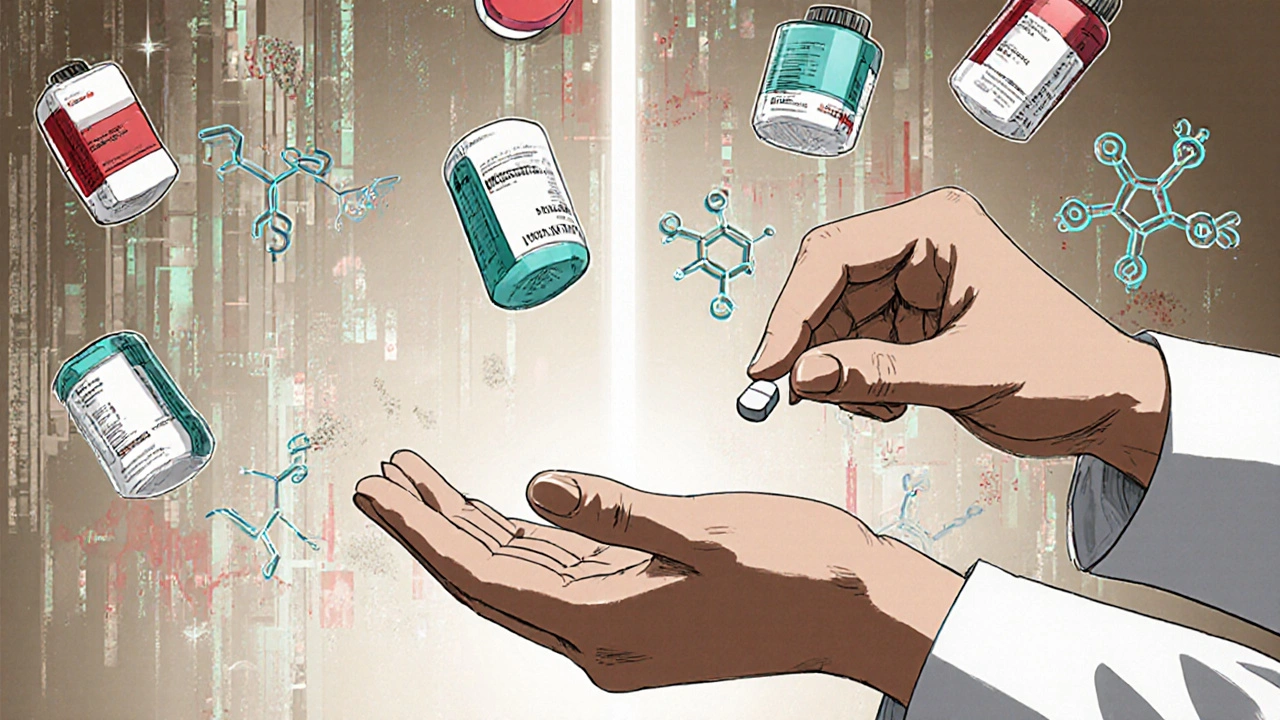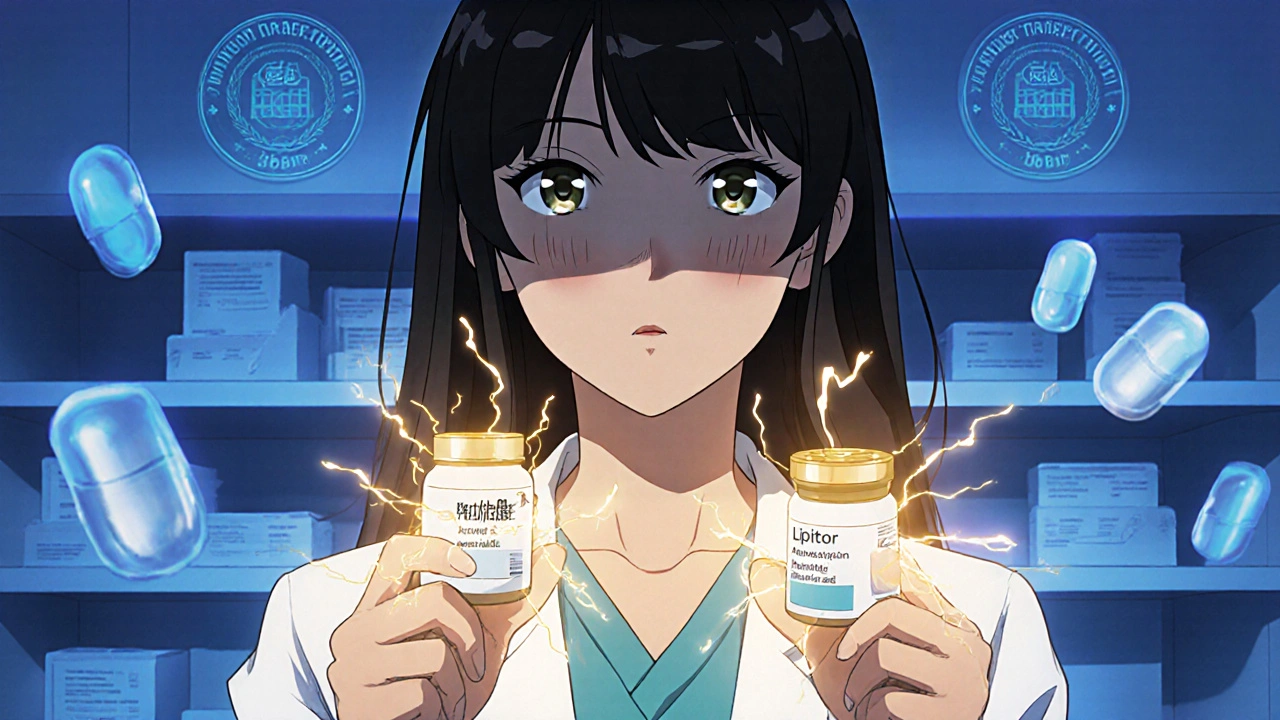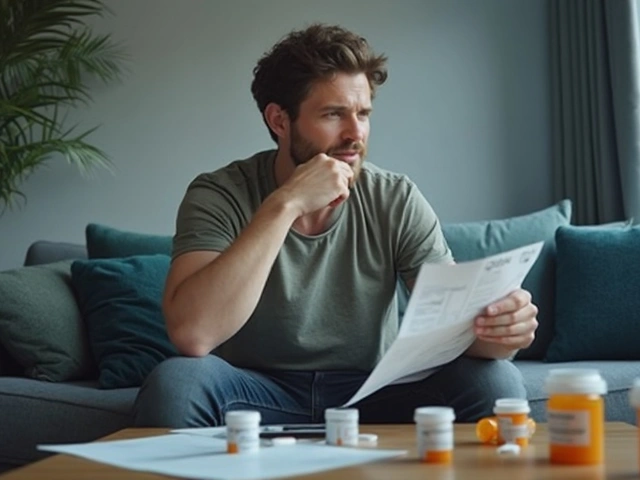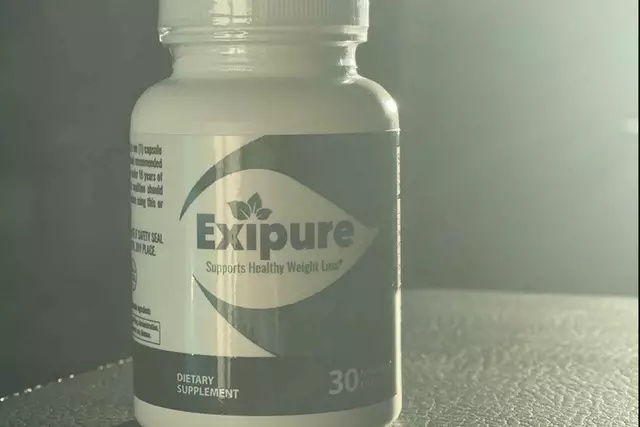Every year, millions of Australians pay hundreds of dollars for prescription meds they could get for a fraction of the cost-without losing effectiveness or safety. The answer isn’t a miracle supplement or a secret coupon. It’s generic drugs. And yes, they’re just as safe as the brand-name versions you’ve been told to trust.
Let’s cut through the noise. You’ve probably heard stories: "My cousin switched to generic levothyroxine and felt awful." Or, "The generic version of my blood pressure pill looks totally different, and I’m scared it’s not the same." These aren’t myths-they’re real experiences. But they’re not the whole story.
What Exactly Is a Generic Drug?
A generic drug isn’t a copy. It’s not a knockoff. It’s the exact same medicine, down to the active ingredient. If your brand-name pill is atorvastatin (Lipitor), the generic is still atorvastatin. Same molecule. Same effect on your body. Same way it’s absorbed. Same way it works to lower cholesterol.
The only differences? The color, the shape, the filler ingredients-like starch or dye-that hold the pill together. These don’t affect how the drug works. The FDA and TGA (Therapeutic Goods Administration in Australia) require generics to prove they deliver the same amount of medicine into your bloodstream as the brand name, within a tight range. For most drugs, that range is 80-125% of the brand’s absorption rate. For high-risk drugs like warfarin or levothyroxine, it’s even tighter: 90-111%.
And here’s the kicker: the same factories that make brand-name drugs often make the generics. The FDA inspects over 1,800 manufacturing sites every year-both domestic and overseas-and holds generics to the same strict standards as brand-name products. There’s no "cheap version" factory. Just the same rules, same inspections, same quality controls.
How Much Can You Actually Save?
Let’s get real about the numbers. A 30-day supply of brand-name Lipitor (atorvastatin) used to cost over $450 in the U.S. The generic? Around $0.50. That’s not a typo. In Australia, the difference isn’t always that extreme, but it’s still massive. A month’s supply of brand-name Plavix (clopidogrel) might cost $300. The generic? $2.50. That’s over 99% savings.
According to the Australian Government’s Pharmaceutical Benefits Scheme (PBS), switching to generics saves patients an average of $500-$1,200 per year per prescription. For people on multiple meds-diabetes, blood pressure, cholesterol-that adds up fast. One 2024 survey found 72% of Australians using generics saved at least $500 annually. For retirees or those on fixed incomes, that’s rent money. Or groceries. Or a dentist visit.
And here’s the best part: you’re not just saving money-you’re more likely to stick with your treatment. People who can’t afford their meds skip doses or stop taking them entirely. A GoodRx study showed 89% of people who switched to generics kept taking their meds regularly. Only 67% of those stuck with brand-name drugs did. Saving money doesn’t just help your wallet. It helps your health.
When Are Generics Not the Same?
Here’s where things get tricky. For most drugs-antibiotics, antidepressants, blood pressure meds, statins-generics work just as well. But there are exceptions. The biggest ones are drugs with a narrow therapeutic index (NTI). These are medications where even a tiny change in blood levels can cause serious side effects or make the drug stop working.
Examples include:
- Levothyroxine (for thyroid conditions)
- Warfarin (a blood thinner)
- Phenytoin (for seizures)
- Lithium (for bipolar disorder)
For these, switching between different generic brands-or even between generic and brand-can sometimes cause problems. One 2023 study found that patients on generic levothyroxine reported inconsistent symptoms 23% of the time, compared to 8% with Synthroid. That’s not because the generic is bad. It’s because tiny differences in how the pill dissolves can affect absorption in people who are extremely sensitive.
But here’s what most people don’t know: you don’t have to switch manufacturers every time. If you’re on levothyroxine and the generic you’re using works fine, stick with it. Don’t let your pharmacist switch you to a different generic unless you’re told why-and even then, ask for a blood test to check your levels.

How to Switch Safely (Without Getting Scared)
You don’t need to be a pharmacist to use generics safely. Here’s how to do it right:
- Ask your pharmacist: "Is this generic made in an FDA- or TGA-approved facility?" You can check the TGA’s database yourself if you want. Most are.
- Check the pill: If the shape, color, or imprint changes, that’s normal. But if it changes twice in a short time, ask why. Multiple switches can confuse your body, especially with NTI drugs.
- Don’t switch NTI drugs unless necessary: If you’re on warfarin or levothyroxine and doing well, stay on the same version-brand or generic. Consistency matters more than cost here.
- Monitor how you feel: After switching, pay attention. Do you feel different? More tired? More anxious? Headaches? Jitters? Track it for 2-4 weeks. If something feels off, call your doctor. Don’t assume it’s "just in your head."
- Ask for the same manufacturer: If your pharmacy has multiple generics for the same drug, ask them to fill your prescription with the same one each time. That’s the easiest way to avoid surprises.
And here’s a pro tip: if you’re on a PBS-subsidised script, you’re already getting the cheapest version. The PBS doesn’t allow brand-name drugs unless there’s a medical reason. So if you’re paying less than $30 for a script, you’re already on a generic.
What the Experts Really Say
Dr. Niteesh Choudhry from Harvard put it simply: "There is really no hard proof that generic medications are any less effective or safe than the originals." The FDA has reviewed over 12,000 generic applications in the last two years. Not one was approved without proving it works the same.
A 2020 study in Nature Communications looked at 17 heart drugs. Guess what? Generics were linked to fewer deaths in 10 of them. Another study of 2.3 million patients in 2024 found that generic statins were just as safe as brand-name ones-if patients stayed on the same manufacturer.
That’s the real secret: it’s not about brand vs. generic. It’s about consistency. Switching brands too often-even between generics-is what causes problems. Not the generics themselves.
What About Biosimilars? Are They the Same?
Biosimilars are the next wave. They’re not traditional generics-they’re complex, biologic drugs made from living cells (like insulin, rheumatoid arthritis meds, cancer drugs). But they follow the same rules: proven to work like the original, approved by regulators, and way cheaper.
As of 2024, Australia has approved over 15 biosimilars. They’re already saving patients tens of thousands per year on drugs like Humira and Enbrel. And yes-they’re just as safe when used correctly. The same rules apply: stick with one version. Don’t switch unless your doctor says so.
Final Thought: Trust the Science, Not the Fear
Generics aren’t "cheap" medicine. They’re smart medicine. They’re the reason millions of people can afford their prescriptions. They’re the reason you’re not choosing between buying food and filling your heart medication.
Yes, there are rare cases where switching causes issues. But those are the exception-not the rule. For 95% of prescriptions, generics are identical in effect, identical in safety, and 80-90% cheaper.
If you’re on a brand-name drug and paying more than $50 a month for it, ask your doctor or pharmacist: "Is there a generic?" If they say no, ask why. Most of the time, the answer is: "There is. You just didn’t know."
Are generic drugs as safe as brand-name drugs?
Yes, for the vast majority of medications. Generic drugs must contain the same active ingredient, strength, dosage form, and route of administration as the brand-name version. They’re required to meet the same strict manufacturing standards set by the TGA and FDA. Regulatory agencies require bioequivalence testing to prove they work the same way in the body. Over 90% of prescriptions in Australia are filled with generics, and studies show they’re just as safe and effective for most conditions.
Why do generic pills look different from brand-name ones?
The difference in appearance-color, shape, or imprint-is due to inactive ingredients like dyes, fillers, or coatings. These don’t affect how the medicine works. Trademark laws prevent generics from looking identical to brand-name drugs, so manufacturers make them visually distinct. But the active ingredient is exactly the same. You can check the pill’s imprint using the TGA’s online database to confirm it’s the correct medication.
Can switching to a generic drug cause side effects?
For most people, no. But in rare cases, especially with narrow therapeutic index drugs like levothyroxine or warfarin, switching between different generic manufacturers can cause minor changes in how the drug is absorbed. This can lead to temporary side effects like fatigue, anxiety, or changes in lab results. These usually resolve within a few weeks. If you notice new symptoms after switching, contact your doctor and ask for a blood test to check your levels.
Should I avoid generics for heart medications or thyroid drugs?
Not necessarily. Generics for these drugs are safe and effective for most patients. But because these are narrow therapeutic index drugs, consistency matters more than cost. Once you find a generic version that works well for you, stick with it. Don’t switch between different generic brands unless your doctor recommends it. If you’re doing well on a brand-name version, there’s no medical need to switch.
How do I know if my pharmacy is giving me a real generic?
All generics sold in Australia must be approved by the TGA. Ask your pharmacist if the generic is listed on the PBS (Pharmaceutical Benefits Scheme) or if it’s an imported generic. You can also check the pill’s imprint code on the TGA’s website or use a pill identifier tool. If the pharmacy can’t tell you the manufacturer or says it’s "not available," ask for clarification. Legitimate generics will have clear labeling and regulatory approval.
Do generics have the same shelf life as brand-name drugs?
Yes. Generics must meet the same stability standards as brand-name drugs. They’re tested to ensure they remain effective and safe until their expiration date. There’s no evidence that generics expire faster or lose potency sooner. Always store them as directed-cool, dry, and out of sunlight-and check the expiration date on the packaging, just like you would with any medicine.
If you’re paying more than you should for a prescription, you’re not being smart-you’re being misled. Generics aren’t a compromise. They’re the standard. And you deserve to get the same medicine without paying the brand-name price.





steffi walsh
November 18, 2025 AT 20:34OMG YES. I switched my mom to generic levothyroxine last year and she’s been sleeping better, less brain fog, and saved $400 a year. Seriously, why are people still scared? It’s the same damn pill with a different color.
Also, her pharmacist switched her to a different generic without telling her and she had a weird week-so yeah, stick with one brand if it works. Don’t be a lab rat.
Riohlo (Or Rio) Marie
November 20, 2025 AT 18:17Oh, sweet mercy, another ‘generics are fine’ pamphlet from the pharmaceutical-industrial complex. Let’s not pretend the TGA’s inspections are some sacred ritual. The same factories that churn out your ‘safe’ generics also supply the black-market opioid pills in Ohio. The regulatory framework? A glitter-coated lie. You think they test every batch? Please. They test one vial from a pallet of 10,000 and call it a day. You’re not saving money-you’re gambling with your endocrine system.
And don’t get me started on the ‘same factory’ myth. Ever heard of ‘contract manufacturing’? Your ‘brand’ Lipitor was made in the same plant as the generic, but the generic? That’s the one that got shipped to Bangladesh for repackaging and came back with a new label and a side of asbestos dust. I’ve seen the invoices.
And yes, I’m the cousin who got awful after switching. You’re welcome for the real talk.
Conor McNamara
November 22, 2025 AT 00:24ok so i read this and i think maybe generics are not safe? i heard from my cousin who knows a guy who works at a pharmacy in dublin that the indian ones have like… extra stuff in them? like talc and stuff that makes you tired? and the colors are different so maybe they changed the chem? i dont trust it. also why do they make them look different if theyre the same? its like a trick. i think the gov is lying. maybe its part of the big pharma agenda to make us sick so they can sell more drugs later? i dont know. i just feel weird.
Leilani O'Neill
November 23, 2025 AT 13:27Of course you’re pushing generics. You’re probably on a government stipend and think saving $500 means you’re a hero. Meanwhile, I’ve been on brand-name Plavix for 12 years because my cardiologist-yes, the one with the Harvard degree-told me generics are a gamble. You don’t get to risk your life because you can’t afford to pay $30 a month. This isn’t about money. It’s about responsibility. And if you’re too lazy to pay for your own health, don’t drag everyone else into your poor life choices.
Also, Australia doesn’t need your American-style cost-cutting. We have a system. Use it. Don’t turn healthcare into a Walmart clearance aisle.
Hal Nicholas
November 23, 2025 AT 16:45So let me get this straight. You’re telling me I should trust a pill that looks like a neon green gumball with ‘A12’ stamped on it… over the blue diamond-shaped pill my doctor gave me for $400? And you’re just gonna say ‘it’s the same molecule’? What about the fillers? What about the coating? What about the fact that my body has been conditioned to recognize that blue pill? You think my anxiety isn’t real? You think my panic attack when I saw the new pill isn’t a legitimate medical response?
And now you’re gonna tell me to ‘track my symptoms’? Like I’m some lab rat with a journal? I’m not a spreadsheet. I’m a human being who’s been stable for a decade. Don’t mess with my stability.
Iska Ede
November 25, 2025 AT 02:31Oh honey. You really think people don’t know that the ‘generic’ version is just the brand-name drug’s ugly cousin who got kicked out of the lab and told to ‘be cheaper’? I mean, come on. The FDA doesn’t ‘inspect’ factories-they take a selfie with the manager and post it on LinkedIn.
And yet somehow, every time I switch to generic, I get the weirdest headaches. Like, ‘why is my left eyebrow twitching?’ headaches. Coincidence? Or is it the mystery dye that’s probably made from crushed beetles and regret?
Also, I’m not paying $50 for my meds because I’m rich. I’m paying because I’m not stupid enough to gamble with my thyroid. You want to save money? Stop buying avocado toast. Not my medicine.
Gabriella Jayne Bosticco
November 26, 2025 AT 11:41My dad’s been on generic warfarin for 8 years. He checks his INR every two weeks. No issues. No hospital visits. He’s 74. Still hikes every weekend.
It’s not about brand vs generic. It’s about consistency. If your pill works, don’t switch. If you’re switching every month because your pharmacy keeps changing it-that’s the problem. Not the generic. The chaos.
Also, if you’re paying more than $30 for a PBS script, you’re doing it wrong. The system’s already giving you the cheapest option. Stop overpaying out of fear.
Gabe Solack
November 26, 2025 AT 21:38Just wanted to add: I’m a pharmacist in Ohio. I fill 200+ generic scripts a week. 98% of patients have zero issues. The ones who do? Usually switching between 3 different generics in 6 months. That’s not the drug’s fault-it’s the system’s fault.
Pro tip: Ask for the same manufacturer every time. Write it on your script. Most pharmacies will honor it. You don’t need to pay extra. Just be specific.
And yes, the same factory makes brand and generic. I’ve walked the floors. No shortcuts. Just cost savings from marketing and patents. Trust the science. But be smart. Consistency > cheapness.
Yash Nair
November 28, 2025 AT 02:40bro you guys are so dumb. america is full of cowards who think generics are dangerous. in india we have 1000s of generic companies and they export to usa and eu and they are 100% safe. we have the best pharma industry in the world. our labs are better than yours. you think your fancy brand name drugs are made in usa? nope. 80% made in india. so why are you scared of the same thing you import? you are just being manipulated by big pharma ads. stop being a sheep. generics are better. cheaper. same. and we made them. 🇮🇳💪
Bailey Sheppard
November 29, 2025 AT 14:31I used to be terrified of generics too. I thought if it looked different, it wasn’t real. Then my insurance forced me to switch to generic metformin. I was ready to panic. But nothing happened. Zero side effects. I even checked my blood sugar logs-same numbers.
Turns out my fear was the only thing that was changing.
Now I ask for generics every time. Saved $600 last year. I still check the pill imprint. I still ask my pharmacist. But I don’t freak out anymore. You don’t have to be scared. You just have to be informed.
And if your doctor pushes back? Ask them to show you the evidence. Most of them don’t even know the PBS covers generics automatically.
Girish Pai
December 1, 2025 AT 00:31Let’s disaggregate the supply chain dynamics here. The bioequivalence thresholds (80–125% AUC) are statistically robust but not biologically deterministic. For NTI drugs, intra-subject variability is the real variable-not the generic per se. The issue is formulation heterogeneity across manufacturers, which introduces pharmacokinetic noise. That’s why the TGA recommends manufacturer consistency for drugs with CYP2C9 or CYP2C19 metabolism pathways. It’s not fearmongering. It’s clinical pharmacology.
Also, biosimilars are not generics. They’re complex molecules with higher lot-to-lot variability. Don’t conflate the two. This post conflates them. That’s irresponsible.
Kristi Joy
December 1, 2025 AT 09:19To anyone scared to switch: I get it. I was there. I thought my thyroid meds were sacred because they were blue and had a fancy logo.
Then I switched to generic. Felt fine. Went back to my doctor. Got my TSH checked. Perfect.
You’re not weak for being scared. You’re human. But you’re not powerless. Ask for the same brand. Track your symptoms. Talk to your pharmacist. You don’t have to choose between safety and savings. You just have to be curious.
You deserve to feel safe. And you deserve to afford it.
Louie Amour
December 2, 2025 AT 15:30Oh wow. Another one of these ‘trust the system’ fairy tales. You really believe the TGA and FDA are independent? They’re funded by the same pharma companies that make the brand-name drugs. The ‘bioequivalence’ tests? Designed by the manufacturers. The inspectors? Former pharma execs. The data? Hidden behind NDAs.
And you think your ‘same molecule’ argument holds water? Molecules don’t feel. Bodies do. I’ve seen patients crash after switching. You think that’s coincidence? Or just the price of profit?
Don’t sell your health for a $500 discount. That’s not smart. That’s surrender.
Kristina Williams
December 4, 2025 AT 14:20my sister took generic and got really sick. she said her brain felt like jelly. they said it was 'normal'. but she had to go to the hospital. so now i only take brand. and i told my whole family. dont trust generics. they are poison. the government is lying. they want us to be sick so they can sell more medicine. i saw a documentary. it was real. i know. i have proof.